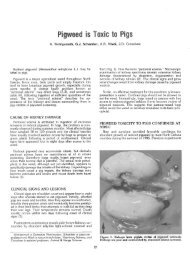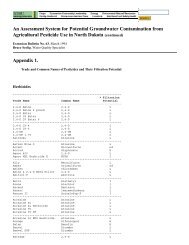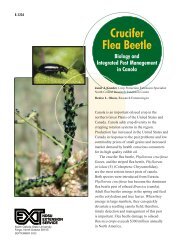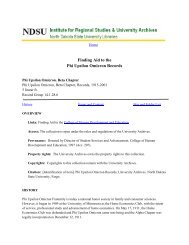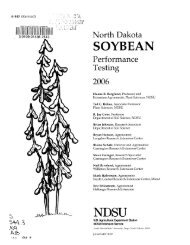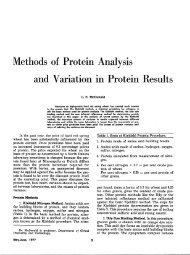germans from russia in fort collins, 1900-2000 - Libraries
germans from russia in fort collins, 1900-2000 - Libraries
germans from russia in fort collins, 1900-2000 - Libraries
Create successful ePaper yourself
Turn your PDF publications into a flip-book with our unique Google optimized e-Paper software.
WORK RENDERS LIFE SWEET: GERMANS FROM RUSSIA IN FORT COLLINS<br />
sugar producers to <strong>in</strong>crease and process the<br />
high sacchar<strong>in</strong>e content of sugar beets. In the<br />
early twentieth century, the impact of the<br />
sugar beet <strong>in</strong>dustry was so dramatic that<br />
many referred to the crop as Colorado’s white<br />
gold. Germans <strong>from</strong> Russia had long grown<br />
the beet as a garden crop, process<strong>in</strong>g it <strong>in</strong>to a<br />
sweet, dark syrup. But Germans <strong>from</strong> Russia<br />
offered the <strong>in</strong>dustry more than just knowhow;<br />
their tenacious work ethic and large<br />
families could provide the labor necessary to<br />
make sugar beets a worthwhile commodity.<br />
Co<strong>in</strong>cidentally, the Germans <strong>from</strong> Russia<br />
who settled on the Great Pla<strong>in</strong>s found government<br />
policies and a treeless terra<strong>in</strong> similar<br />
to that which their ancestors encountered <strong>in</strong><br />
Russia a century earlier. As the republic<br />
spread across the cont<strong>in</strong>ent, officials <strong>in</strong><br />
Wash<strong>in</strong>gton, like Cather<strong>in</strong>e <strong>in</strong> Russia, were<br />
concerned about the vast amounts of un<strong>in</strong>habited<br />
land and provided land grants and<br />
unprecedented <strong>in</strong>dependence to those will<strong>in</strong>g<br />
to settle there. Also, the federal government<br />
sought a culturally superior buffer <strong>in</strong> the west<br />
to what it considered primitive natives. On<br />
the treeless prairie, German Russian’s mudbrick<br />
construction, dry-farm<strong>in</strong>g techniques,<br />
and work ethic made them successful <strong>in</strong> a<br />
wilderness many Americans still considered a<br />
desert. Indeed, the sod house, an American<br />
icon, may well have been an <strong>in</strong>novation of the<br />
Germans <strong>from</strong> Russia. 22<br />
The first Germans <strong>from</strong> Russia who<br />
came to the United States arrived <strong>in</strong> the 1870s<br />
<strong>from</strong> the Black Sea region. From eastern port<br />
cities, they settled throughout the Midwest<br />
and West, but Kansas, Nebraska, and the<br />
Dakotas drew the largest numbers. Those<br />
who settled <strong>in</strong> these areas brought with them<br />
hard, Turkey red wheat they had cultivated <strong>in</strong><br />
Russia, transform<strong>in</strong>g the Great American<br />
Desert <strong>in</strong>to the breadbasket of the world.<br />
Particularly notable German-Russian populations<br />
evolved <strong>in</strong> Russell and Ellis counties <strong>in</strong><br />
western Kansas. The earliest Germans <strong>from</strong><br />
Russia to settle <strong>in</strong> Colorado arrived <strong>in</strong> 1880-<br />
81 as laborers on the Chicago, Burl<strong>in</strong>gton &<br />
Qu<strong>in</strong>cy and the Kansas (later Union) Pacific<br />
railroads. In the mid-1880’s, a German-<br />
Russian settlement evolved <strong>in</strong> Globeville,<br />
northeast of Denver. The first German-<br />
Russian laborers arrived to work <strong>in</strong> sugar beet<br />
fields near Brighton <strong>in</strong> 1886. These communities,<br />
however, rema<strong>in</strong>ed small until the<br />
boom of Colorado’s sugar <strong>in</strong>dustry <strong>in</strong> the first<br />
decade of the twentieth<br />
century. 23<br />
The relationship<br />
of the sugar beet<br />
<strong>in</strong>dustry to Germans<br />
<strong>from</strong> Russia is critical<br />
to understand<strong>in</strong>g their<br />
settlement <strong>in</strong><br />
Colorado, especially<br />
<strong>in</strong> Fort Coll<strong>in</strong>s. The<br />
sugar beet <strong>in</strong>dustry<br />
would have been hard<br />
pressed to f<strong>in</strong>d the<br />
labor it required without<br />
Germans <strong>from</strong> Russia; their large families<br />
and <strong>in</strong>satiable work ethic provided cheap<br />
and dependable stoop labor. Conversely,<br />
most of the Germans <strong>from</strong> Russia who toiled<br />
<strong>in</strong> the state’s beet fields needed the employment<br />
s<strong>in</strong>ce they had arrived too late to take<br />
advantage of liberal homestead<strong>in</strong>g policy and<br />
land prices were too high for the impoverished<br />
immigrants to purchase farms.<br />
Emigrat<strong>in</strong>g <strong>from</strong> the Volga River region of<br />
Russia, these Germans arrived nearly two<br />
decades after those <strong>from</strong> the Black Sea<br />
region. Over three-quarters of those who ultimately<br />
settled <strong>in</strong> Larimer County came <strong>from</strong><br />
the Volga region. 24 Largely Protestant, these<br />
immigrants were far less will<strong>in</strong>g to assimilate<br />
because of generations of isolation and the<br />
Figure 2.<br />
Sugar beet. (Great Western Sugar<br />
Company, 1916)<br />
SWCA Environmental Consultants Page 5



